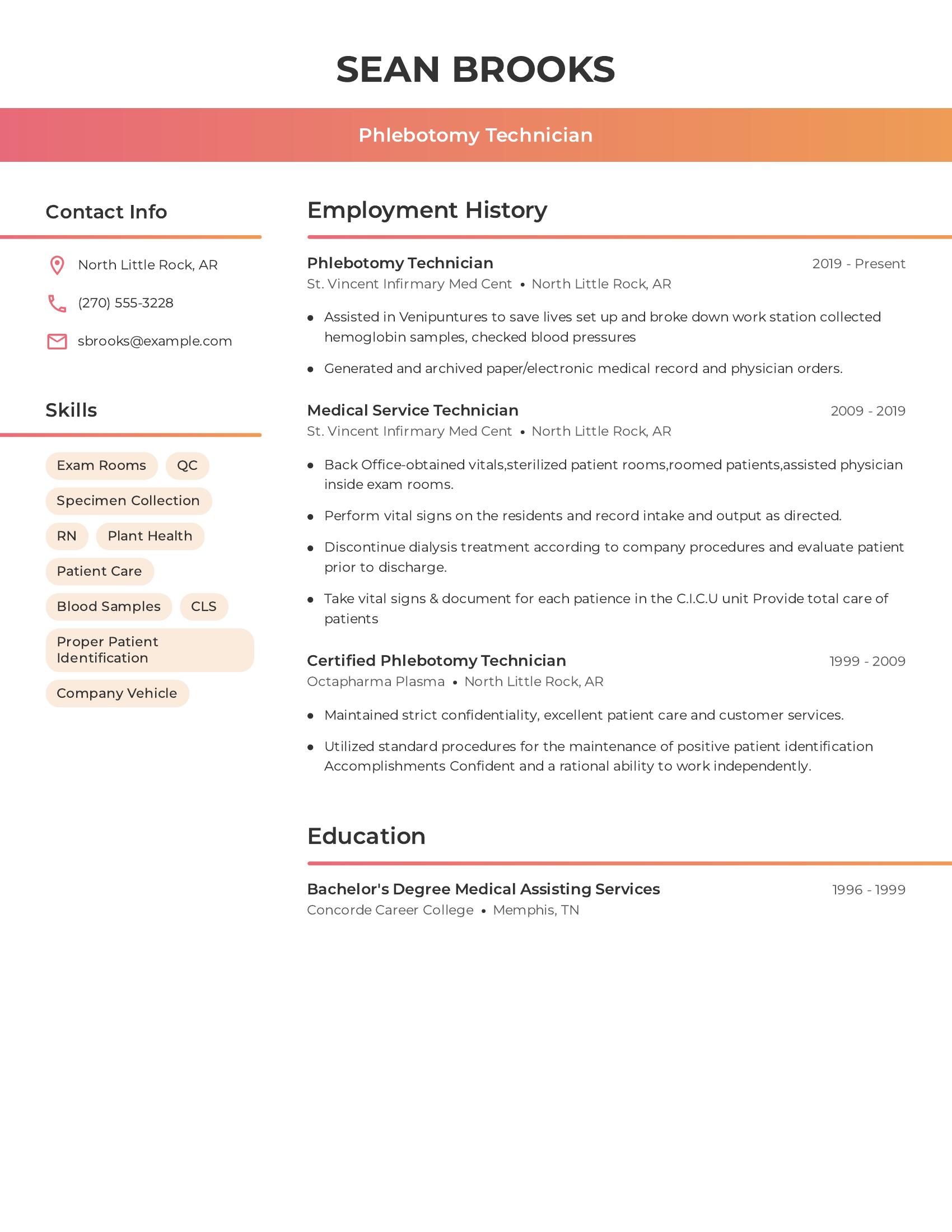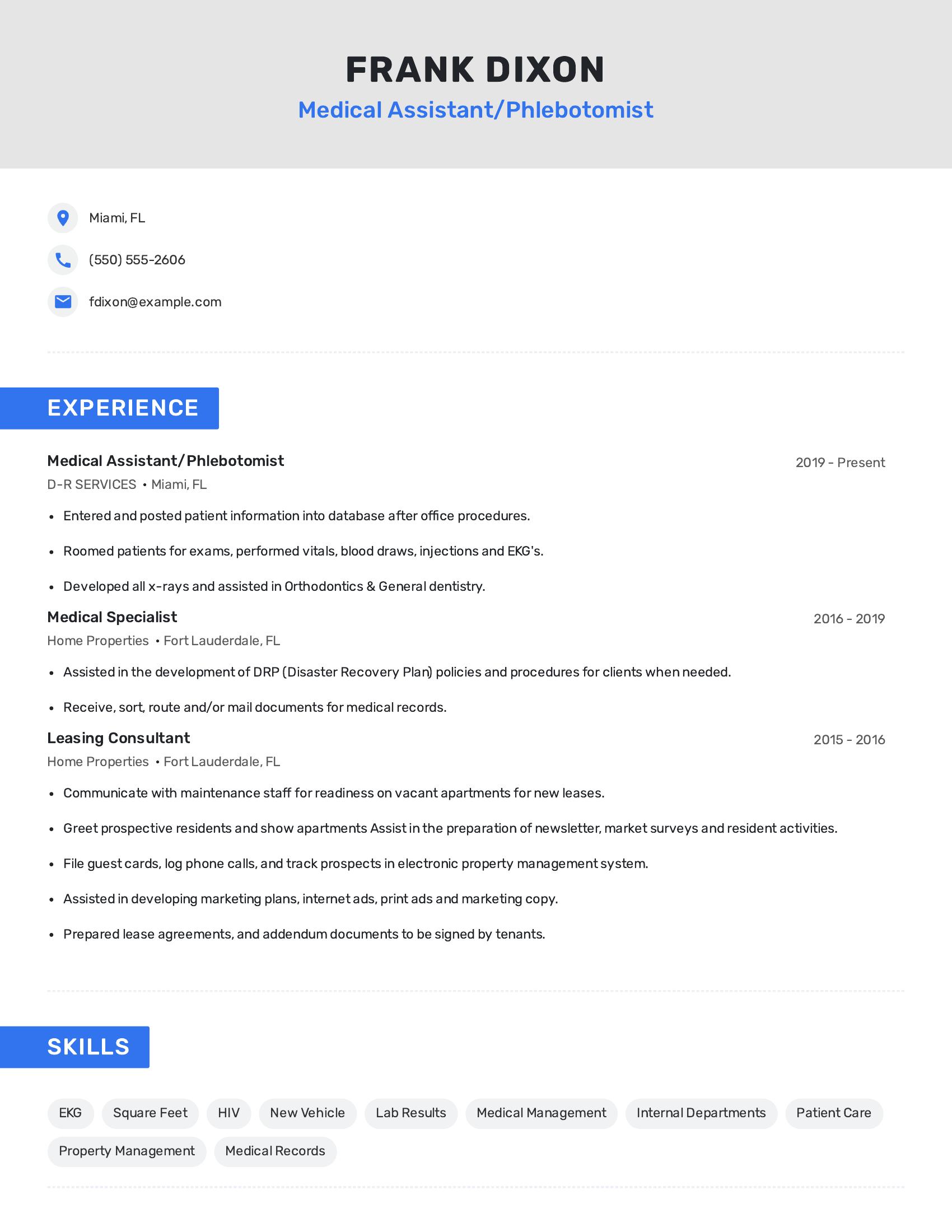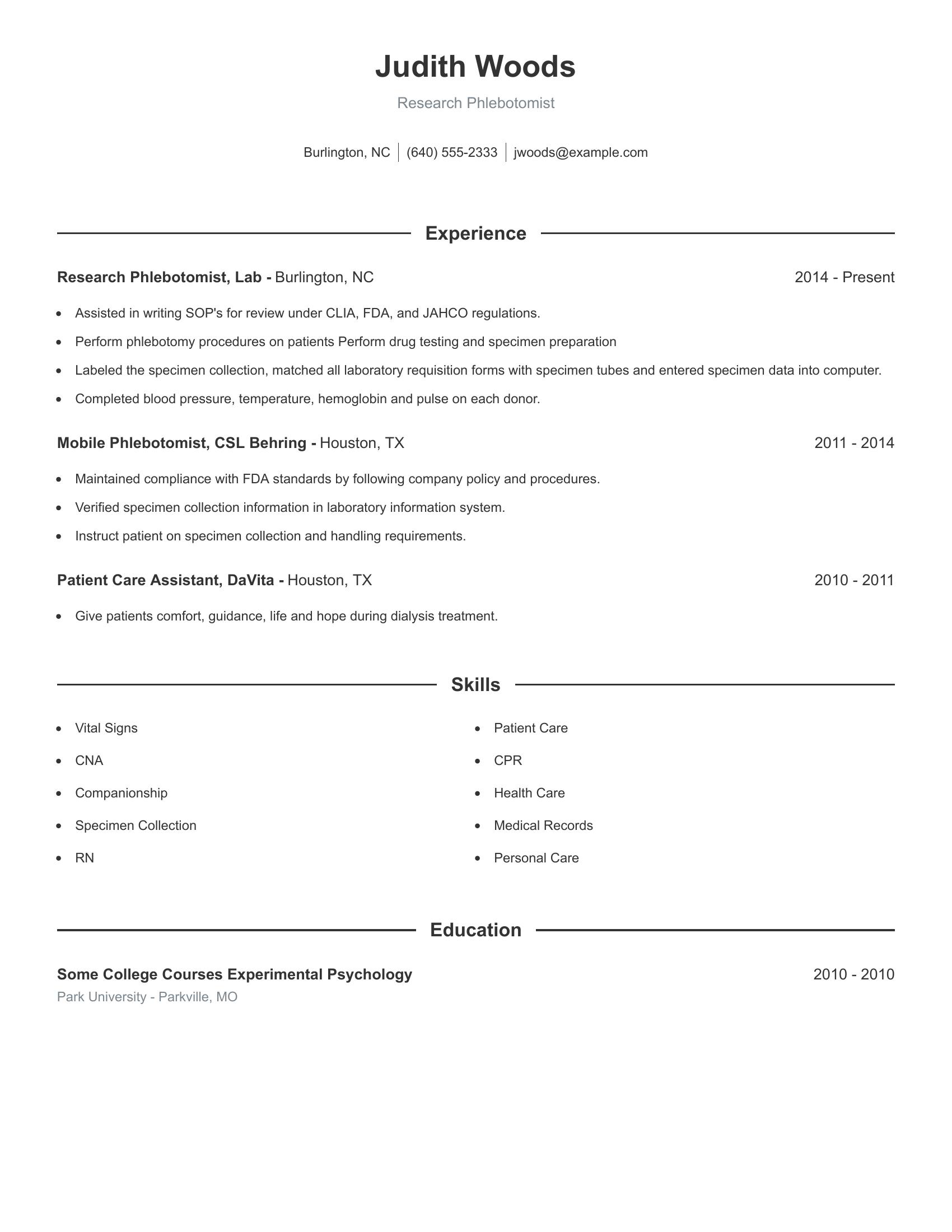17 Phlebotomist Resume Examples




Phlebotomist resumes should highlight relevant experience, technical skills, and proficiency in patient care. Key elements include job titles, employment dates, and specific duties performed such as specimen collection and venipuncture. It is important to mention certifications, knowledge of safety protocols, and any specialized training or externships. Strong resumes also list relevant soft skills like communication and data management abilities.
This resume is effective because it details the candidate's experience with various phlebotomy tasks including blood draws, specimen collection, and quality control in different settings. It lists specific skills such as proficiency with Epic and vacutainer tubes. Additionally, the resume mentions compliance with OSHA standards and experience with patient care, which are crucial for the role of a phlebotomist.

Certified phlebotomist resumes should highlight relevant job experience, specific skills in phlebotomy, and educational background. They should include details on job duties like blood draw procedures, patient care, and lab equipment handling. Additionally, certifications, internships or externships, and any special training or techniques used in phlebotomy are important to list. Contact information should be clear and skills should be listed to show expertise.
This resume includes detailed employment history with specific duties such as setting up a phlebotomy drawing center and handling infection control. It lists relevant work experience from different roles within the same field, which shows progression. The resume also mentions an associate's degree and skills related to phlebotomy and lab tasks. It provides contact information clearly and enumerates specific skills that demonstrate proficiency in the required areas of the job.

Laboratory phlebotomist resumes should highlight relevant skills, employment history, and education. Important skills include specimen collection, lab tests, patient care, and knowledge of lab equipment. The employment history should detail specific responsibilities like patient care and venipuncture. Education should reflect a background in medical or health sciences.
This resume includes the necessary specifics for a laboratory phlebotomist position. It lists relevant skills such as specimen collection and lab tests. The employment history details duties like providing patient care and performing venipuncture. The education section shows a relevant degree in nursing, which supports the candidate's qualifications.

Clinical phlebotomist resumes should highlight relevant skills, employment history, and education. Key skills include specimen collection, operating lab equipment, and patient care. Job experience should show a history of similar roles, demonstrating the ability to handle clinical responsibilities and work in various healthcare settings.
This resume includes specific skills like body fluids, specimen collection, and lab results. It lists relevant job titles such as clinical phlebotomist and phlebotomy technician. The employment history details experiences in different medical environments, from nursing homes to hospitals. Education is briefly mentioned, showing some college coursework in medical assisting services.

Phlebotomy technician resumes should highlight relevant experience, skills, and education clearly and concisely. This includes listing job titles, employment history with dates, specific duties performed, and any certifications or educational qualifications. Skills pertinent to the job such as specimen collection, patient care, and proper patient identification should be emphasized. Avoid unnecessary jargon and keep information straightforward.
This resume effectively includes specific job titles and employment history with clear dates, showing a long-term commitment to the field. It lists relevant skills like specimen collection and patient care directly related to phlebotomy. The education section is concise, providing the degree earned and the institution attended. The resume also details duties performed in previous roles without unnecessary words, making it easy to read.

Mobile phlebotomist resumes should highlight relevant experience, education, and skills. They should include job titles, employers, locations, and dates of employment. Key responsibilities like blood drawing, specimen collection, and patient care are important. Education details should list degrees and institutions. Skills like compliance with SOPs and knowledge of bloodborne pathogens are also crucial.
This resume includes specific job titles and responsibilities at different employers. It lists relevant tasks like entering insurance information and collecting payments. The resume mentions important skills such as patient care and compliance with guidelines. It also includes educational background with degrees and colleges attended.

Laboratory assistant/phlebotomist resumes should highlight relevant experience, skills, and education. These resumes should include employment history with specific duties, certifications, and compliance with medical guidelines. Skills like specimen collection, lab tests, and knowledge of safety standards are important. Education details should reflect relevant degrees or certifications in medical fields.
This resume effectively includes the necessary specifics. It lists detailed employment history with clear job duties at each position, such as following FDA and OSHA guidelines and preparing human samples. The skills section includes important abilities like specimen collection and lab tests. The education section shows a relevant degree in Medical Assisting Services from Remington College.

Laboratory technician/phlebotomist resumes should highlight relevant experience, skills, and education. Key elements include detailed job descriptions, showcasing hands-on experience in venipuncture, specimen collection, and lab testing. The resume must demonstrate familiarity with safety protocols and patient care. Educational qualifications and certifications should be clearly stated. Clear contact information and a concise summary of skills are also crucial.
This resume includes specific job duties like venipuncture and specimen handling, showing real-world experience. It details roles in various settings like main labs and emergency departments, reflecting versatility. The resume lists relevant skills such as vital signs and lab tests, indicating a comprehensive skill set. Education is clearly stated with degree information and major, making qualifications evident.

Outpatient phlebotomist resumes should highlight specific skills and experience relevant to the role. These include patient care, safety procedures, and compliance with regulatory standards like OSHA and FDA. It should also demonstrate proficiency in technical tasks such as blood draws, specimen collection, and use of medical software. Additionally, prior job experience in similar settings and relevant education are important.
This resume includes many of these specifics. It lists skills like patient care and computer applications. It shows experience with safety procedures and regulatory compliance. It details job roles at different employers, demonstrating a consistent work history in the field. It also mentions an associate's degree in medical assisting services, supporting the candidate's qualifications.

Medical assistant/phlebotomist resumes should highlight relevant experience, technical skills, and certifications. A good resume includes clear job titles, dates, and locations for each role. Responsibilities should be specific and related to patient care, medical procedures, and administrative duties. Technical skills like EKGs, blood draws, and managing patient records are important.
This resume includes detailed job experiences with clear responsibilities like performing vitals, blood draws, and EKGs. It shows a progression in roles from leasing consultant to medical assistant/phlebotomist. Skills listed are relevant to the field such as patient care and medical records management.

Phlebotomy externship resumes should highlight relevant experience, education, and skills. Key elements include the job titles, employers, locations, and dates of employment. Responsibilities and achievements should be clear and concise. Important certifications, technical skills, and education must also be included. The resume should demonstrate the candidate's ability to handle medical tasks and work well in a team.
This resume includes specific details about the candidate's phlebotomy externship experience. It lists roles at CSL Behring with responsibilities like documenting biohazard waste disposal and maintaining FDA compliance. It also shows collaboration with coworkers and doctors. Skills such as OSHA knowledge, EKG, blood samples, and patient care are mentioned. The education section includes an associate's degree in medical assisting services, which supports the candidate’s qualifications for a phlebotomy externship.

Certified phlebotomy technician resumes should emphasize relevant skills, work experience, and education. Key sections include contact information, skills related to phlebotomy and patient care, a detailed employment history, and educational background. The resume should demonstrate proficiency in blood draws, specimen collection, and lab procedures. It should also mention experience with different age groups and teamwork in a healthcare setting.
This resume includes the necessary elements for a certified phlebotomy technician. It lists specific skills like specimen collection, blood samples, and lab tests. The employment history highlights experience at various healthcare facilities performing relevant tasks such as venipunctures and coordinating specimen processing. The educational background with a degree related to medical assisting further supports the candidate's qualifications.

Registered phlebotomist-part time resumes should list relevant work experience, certifications, and skills. This includes specific tasks like specimen collection, shipping, and patient interaction. Experience with computer systems and maintaining accurate records is important. Highlighting collaboration with healthcare professionals and customer service is also beneficial.
This resume covers the necessary details well. It lists specific duties like handling stat calls, processing specimens, and performing venipunctures. It also shows good communication skills with healthcare teams and includes experience in different settings. The resume mentions familiarity with computer systems and regulatory compliance.

A research phlebotomist resume should highlight relevant experience in specimen collection, compliance with medical standards, and patient interaction. It should also demonstrate knowledge of regulatory requirements, technical skills, and previous work history in similar roles. Clear contact information and a concise summary of education and skills are crucial components.
This resume includes specific job roles and responsibilities like performing phlebotomy procedures, drug testing, and specimen preparation. It shows experience in maintaining compliance with FDA standards and writing SOPs under various regulations. The resume also lists relevant skills such as vital signs monitoring, patient care, and medical records management, along with some college coursework in experimental psychology.

Medical laboratory assistant resumes should include clear employment history, relevant skills, and education. Key elements are job titles, tasks performed, and any certifications or courses. Specific tasks like drawing blood, performing EKGs, and patient care highlight hands-on experience. Listing past roles with detailed responsibilities shows a broad skillset applicable to the role.
This resume contains these specifics well. It outlines job titles and tasks such as drawing blood, performing EKGs, checking vital signs, and assisting with surgeries. The resume also lists relevant skills like patient care and physiology. Education includes medical assisting courses, showing specialized training. This structure makes it easy to identify qualifications at a glance.

Phlebotomist supervisor/instructor resumes should highlight leadership abilities, hands-on experience in blood collection, and the ability to train and manage staff. Key elements include work history, specific duties performed, and core skills like handling laboratory equipment, processing specimens, and maintaining compliance with regulations. The resume must also reflect experience in both supervisory roles and direct patient care to show versatility.
This resume includes all necessary specifics. It lists job titles with corresponding dates and locations, showing career progression. Duties like supervising employees, training staff, and enforcing guidelines are clearly stated. Skills such as phlebotomy techniques, specimen processing, and equipment preparation are mentioned. Additionally, it notes experience in various medical environments and roles, emphasizing a well-rounded background in both technical and managerial aspects.

Clinical laboratory assistant resumes should include specific sections that highlight technical skills, relevant experience, and adherence to regulatory standards. Key elements include job titles, dates of employment, and descriptions of tasks performed. Specific duties such as venipuncture, specimen processing, and compliance with regulations should be clear. Experience in different departments like chemistry and microbiology adds value. Contact information and location are also essential.
This resume includes detailed work experience in various roles such as clinical laboratory assistant, medical laboratory assistant, and laboratory technician/phlebotomist. It lists specific tasks like performing venipuncture, EKG testing, and completing tests using HLA Class 1 typing by PCR. The resume also shows compliance with CAP, CLIA, and COLA regulations, and indicates experience in both front desk tasks and direct patient care activities. This variety demonstrates a well-rounded skill set.

Clinical medical assistant resumes should highlight relevant experience, technical skills, certifications, and education. Key areas to include are hands-on patient care, familiarity with medical procedures, administrative duties, and specific certifications like CPR. The resume should be concise, easy to read, and provide clear evidence of the applicant's capabilities and achievements.
This resume includes detailed descriptions of job responsibilities such as preparing exam rooms, assisting with research studies, and handling daily patient care. It lists specific skills like medical billing, vital signs monitoring, and lab equipment handling. The inclusion of certifications and education further demonstrates the candidate's qualifications. The format needs improvement but the content effectively showcases the applicant's experience and skills.

Highlight your experience. List past roles as a phlebotomist, mentioning the types of patients you worked with and the number of blood draws per day.
Detail your skills. Include skills like venipuncture, patient communication, and safety protocols. Mention any certifications like CPT or ASCP.
Showcase your education. List relevant courses or training programs you completed. Mention any degrees or diplomas related to healthcare or phlebotomy.
A phlebotomist's resume should highlight their skills, certifications, and experience. Focus on relevant qualifications and direct patient care. Include contact information, a summary statement, work experience, education, certifications, and skills.
A phlebotomist summary should highlight your experience, skills, and certifications. Mention your years of experience, types of facilities you have worked in, and any relevant training.
Keep it short and relevant. Use bullet points for easy reading. Focus on your hands-on experience and specific skills. Tailor the summary for each job application.
Highlight your skills and specific tasks related to drawing blood and handling samples.
Focus on clarity and relevance. Avoid unnecessary details.
A phlebotomist needs specific technical skills to perform their job well.
A phlebotomist also needs soft skills to interact well with patients and coworkers.